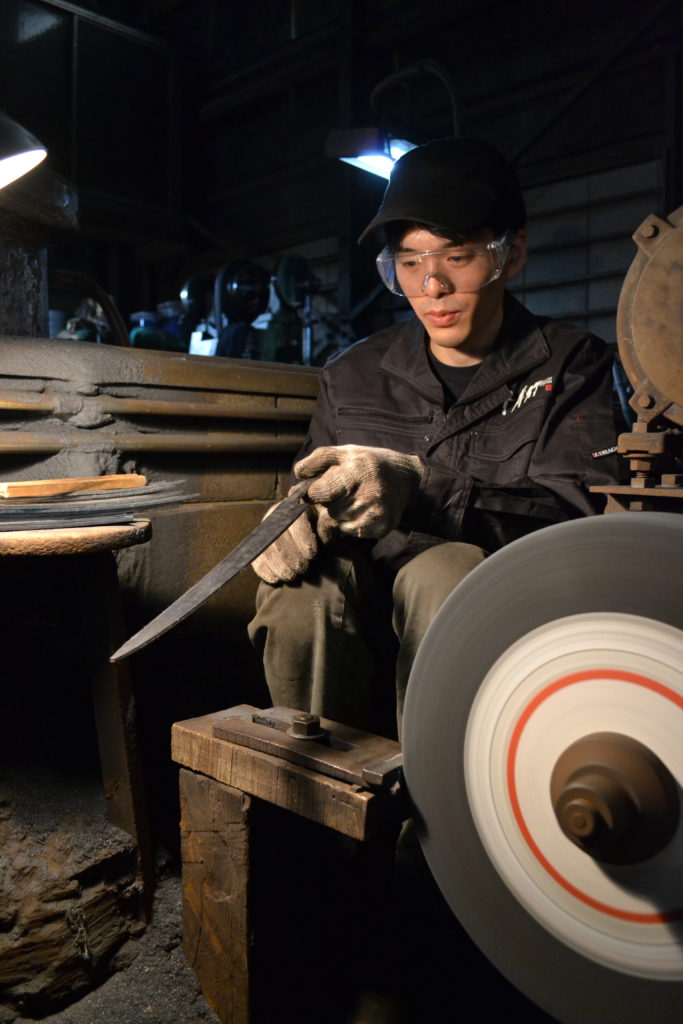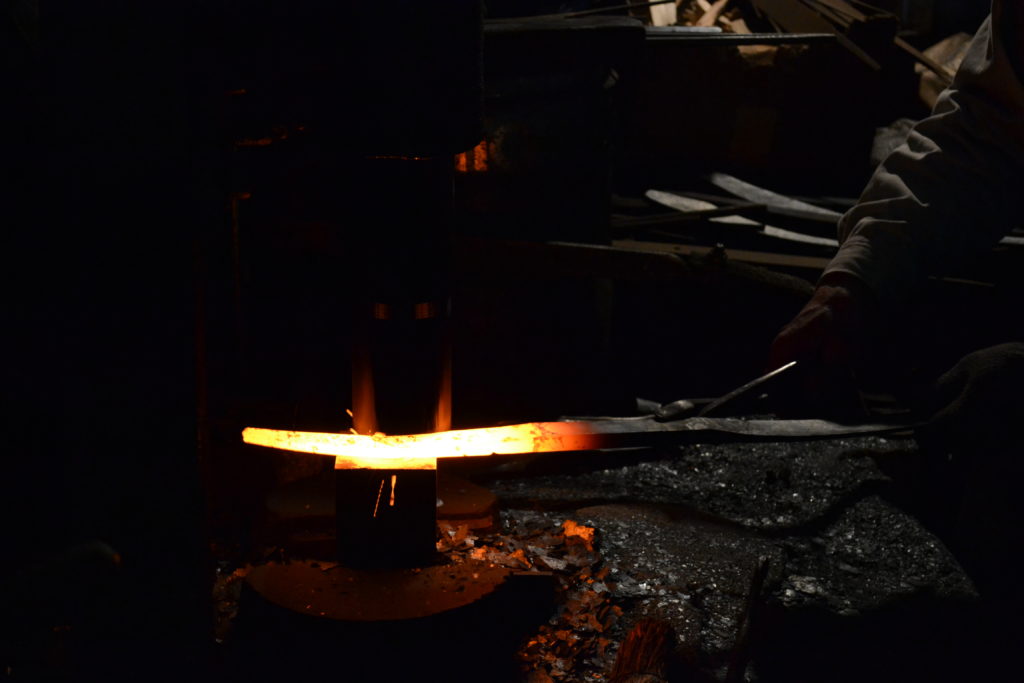Master Blacksmith Yoshio Yamashita and his apprentice, Ryosuke Shibata, craft our Sakai Takayuki Kasumi series. Learn more about their history and knife making process.

Tell us a little about how you became a blacksmith.
Yamashita: My father was a blacksmith and I always knew that I'd follow in his footsteps. I have been doing this for 52 years now, I started as my father's apprentice when I was 18 years old. Now I'm 70 and still working as a blacksmith.
Shibata: Back when I was in middle school, I used to go mountain climbing and fishing at the seaside. I used normal, store bought knives and couldn't find much that was both designed well and cut well within my price range. One day while researching on the Internet I found out that yes, indeed, you can make knives yourself. It became my hobby and as I was getting better at it I became increasingly interested in the craft and finally decided to make it my job.

What is the process for forging a single-edged blade?
Yamashita: Here are the steps.
Forge Welding and Forging
To make our knives we use mild steel with next to no carbon in it for the cladding, and a high carbon steel called white steel for the cutting layer. The first step is to take a one-meter long bar of high carbon steel, hammer flat enough material for one knife at one end and cut it off. A chemical acting as an adhesive of sorts is then applied to help forge weld it to a bar of mild steel at a temperature of about 1050 degrees centigrade. After roughly hammering it into shape, the knife blank is cut off from the bar and a tang is formed from a bit of mild steel left over at the rear. The entire knife is hammered until it’s close to the desired measurements. After the forging process is complete the knife is annealed, meaning it's cooled slowly to remove internal stress and strengthen it.

Shaping and Finishing
Once cool, the knife is again hammered to remove the oxide layer that formed on the surface of the knife during forging. Switching from hand to belt hammer, the knife is further shaped and thinned out without heating it. After this, the blank is cut into shape along a template using a hand operated shearing machine. Hammering the backside of the blank gives it its characteristic hollow shape. Any warping that may have occurred until now is hammered out and the blank straightened. Using a grinder and a buffer, the surfaces of the knife are smoothened as a final step.

Heat treatment
Next, clay is applied to the surface of the knife and it is laid on top of the furnace to dry. This is to control the speed of the temperature changes that will occur during hardening and to protect the surface of the knife. Using a mixed coal and coke fire, the knife is heated to a temperature of about 780º centigrade and then quenched in water. After hardening is complete, the knife is tempered at about 180º centigrade. Using a small hammer, warp and distortion caused by hardening are corrected and the protective layer of clay is taken off, marking the end of the blacksmith's work.
What does a typical work day forging look like for you?
Yamashita:
After lighting a fire in the morning, I forge around ten to fifteen knives, after which I heat treat the ones that Shibata-san prepared and finished.
Shibata:
I shape and finish the blanks my master forges. Working at the same pace as he does, I do about ten to fifteen knives a day.

Is there part of the process that is particularly challenging or satisfying for you?
Yamashita:
The forge welding of mild steel and carbon steel is hard but is also especially satisfying when everything goes well. What makes it hard is that you have to strike a balance between a multitude of factors such as the mixture of the borax and boric acid we use as an adhesive, the temperature of the coke fire and the timing and technique of your hammering. Heat treatment is also very important for bringing out the full potential and characteristics of the steel, so if that goes well, I'm just as happy.
Shibata:
Cold hammering the knife blanks with the belt hammer is hard, as you have to make minute, three dimensional adjustments to a blank which tapers both from heel to tip and from spine to edge. My work on this step also affects the following grinding and sharpening, so I'm especially careful.

Favorite steel type to work with and why?
Yamashita:
I like to work with Yasuki White #3 Steel. Compared to White #2's 1.1% of carbon, White #3 comes with 0.85% carbon, making it slightly softer. On the other hand, its tougher and less brittle, making it less prone to chipping. Compared to White #2, there are also fewer problems with forge welding and heat treatment, making it easier to achieve consistent quality.

How do you think Sakai can attract more young apprentices to keep the craft of forging alive?
Yamashita:
Working as a blacksmith means working in constant heat with your hands and getting your clothes dirty. While it's demanding and not many young people today want to do this kind of work, making knives also gives you a sense of accomplishment. In a way, they are like our children we bring into this world. Thinking about how they get put to work and how they perform in many kitchens around the world makes me really happy.
The job has its downsides, but I would like young people to see these positive aspects as well and get involved.
The passing on of knowledge and techniques can't all be done by putting it into words and writing a manual. Just like Shibata-san, who is training under me, you first watch and memorize the movements and repeat and refine them every day at work. Meanwhile I will gradually teach the basic techniques and movements and let the apprentice advance step by step. It's important to gain experience as to which ways of doing it work well and which don't. That's why normally it takes about five to ten years to really know what you're doing.
Shibata:
When I was looking for a master to train with, the biggest problem was finding someone who would be willing take on an apprentice in general, as many blacksmiths who work on their own don't have the means to pay an apprentice's wage. Many places don't pay any money or you even have to pay them to teach you. Now I'm employed regularly at Aoki Hamono, the wholesaler and knife maker behind Sakai Takayuki, and train under master Yamashita who works independently. That way I can make a living and focus on my training.
This model of apprenticeship is extremely rare in Japan and I don't know if it will catch on among knife makers and blacksmiths, but I do believe it could help with finding the next generation of craftspeople to carry on the tradition.
In a few decades, when I'll be ready to take on an apprentice of my own, I too will try to come up with a setup that allows for the apprentice to live a reasonably comfortable life while in training.
Regarding the passing on of skills and techniques I agree with my master. It's important to first watch and repeat and gradually get experience.
I'm only in my first year of training but I want to continue giving my best learning something new every day.

Any thoughts on why Japanese knives have become so popular overseas?
Yamashita:
Sushi and other Japanese food have been seeing a worldwide boom, while people around the world had a chance to to use Japanese knives. Through that, they learn about the special sharpness and feel of traditional single bevel knives. I also think that they are beautiful and have a mystique around them, a sacred feel even, linking them to the traditions of Japanese swords.
Shibata:
Traditional Japanese knives are used and sharpened in unique ways. Now there may be people who feel that they're a bit hard to use but a well sharpened single bevel knife actually allows for smooth cutting that's easier on the ingredients than cutting with a normal knife. I believe traditional Japanese knives to be valued as tools that help bring out the best in beauty and taste of sophisticated cuisine.
